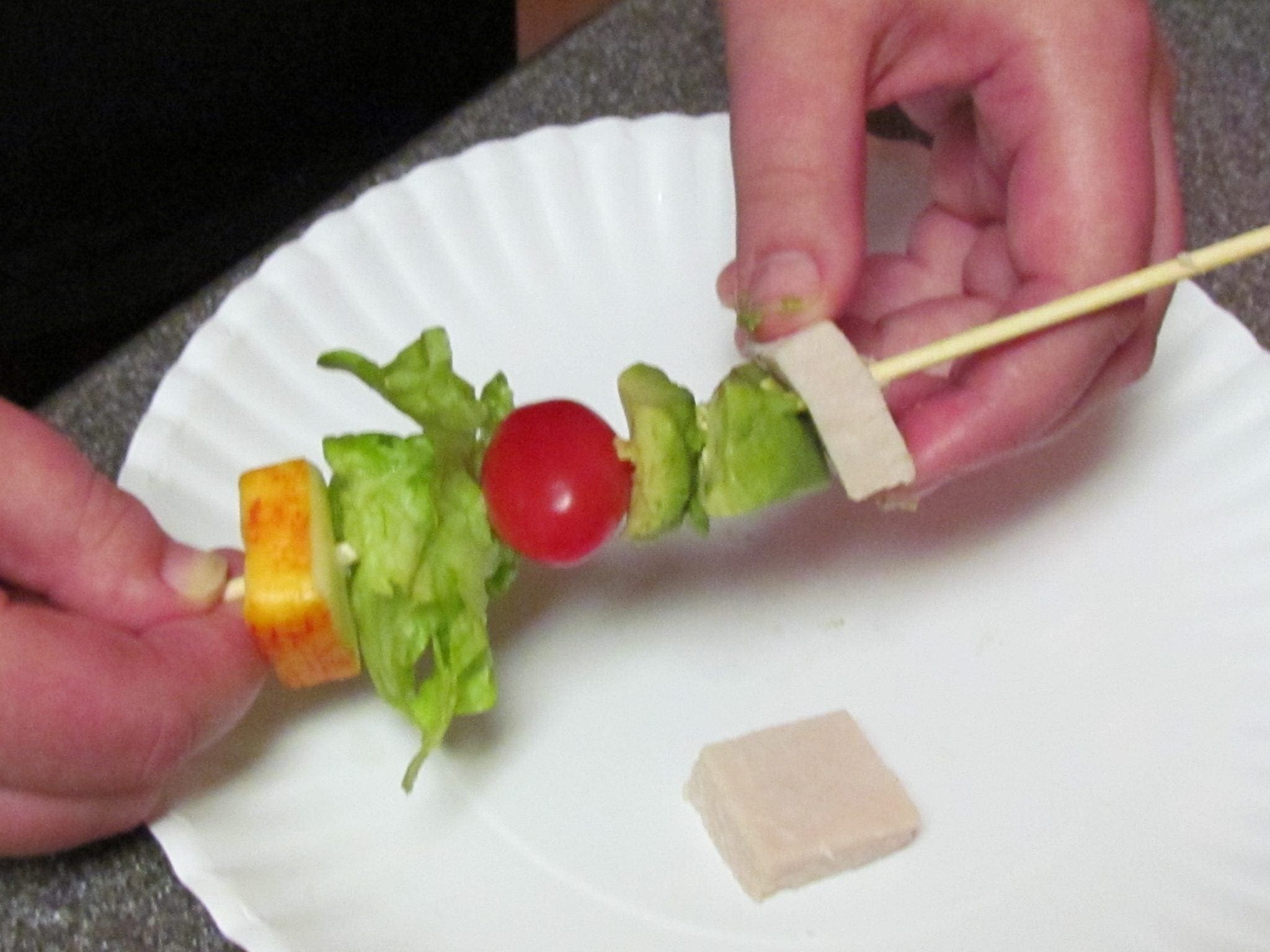Encouraging Speech & Creating Yum! Kiddie Cobb on a Stick
Everything taste better on a stick and these Kiddie Cobb’s on a Stick are fun to make. Plus, they are easy to transport for picnics or any summer fun activity. They are packed with protein that will stick with your kids through the day. We used smoked turkey for the flavor that typically comes from bacon, and “drizzled” blue cheese dressing over the final, finished product.
Kiddie Cobb on a Stick Ingredients
- 1 head red leaf lettuce
 [2]
[2] - Cherry tomatoes
- 1 small ripe avocado; cut in chunks
- 1 or 2 slices *smoked turkey; sliced at deli about ½” thick (then cut into chunks or squares)
- 4 hard-boiled eggs; peeled and chopped in 1/2
- 2 slices *Muenster Cheese; sliced about ¼ inch thick at deli. You could also use pre-packaged/cubed.
- Serve with blue cheese dressing
*Recipe uses All Natural Boars Head Smoked Turkey Breast and all Natural Boars Head Muenster Cheese that are *Feingold approved.
Kiddie Cobb on a Stick Instructions/Preparation
Parent: Hard boil eggs and peel in advance.
Parent/Kiddo: Wash lettuce leaves and tomatoes and dry with paper towel.
Kiddo: “rip and tear” lettuce leaves in to bite size pieces.
Parent/Kiddo: Peel and remove seed from avocado, then cut into chunks.
Parent/Kiddo: Cut smoked turkey and cheese in to chunks.
Assembly
Parent/Kiddo: Thread cheese, lettuce, tomato (sideways), smoked turkey, repeating the pattern onto wooden skewer. Make sure to leave room at the top for the egg.
Serve by drizzling dressing over the skewers. Refrigerate any leftovers.
Eat! Talk! Enjoy!
Note: we had these for dinner and again the next day for lunch and the avocados were fine, however, you may want to cut avocados and assemble the skewers the morning or day of your event.![]() [6]
[6]
Language Time:
Cooking together can be a fun and multi-sensory activity for you and your child. Focusing on a simple recipe with your child will allow you to work on language while having fun. Have a child with an allergy or a special diet? This recipe is super easy to modify and swap ingredients.
Before beginning the recipe, review the ingredient list with your child. This will help your child become familiar with the ingredients while expanding vocabulary. Explore each ingredient and describe the taste and feel of the ingredients (e.g. lettuce is green and crunchy, tomatoes are red and juicy). Each ingredient can be its own language activity! For example, when presenting an unpeeled avocado to your child, ask your child “How should I get this open”? This can be a great exercise for problem-solving. Ask them to guess what color the avocado is inside and discuss the texture of the peel and how it compares to the smoothness of the avocado. Explore the pit inside (discuss color, shape, feel, etc…).
Work on actions such as boil (when you boil the eggs), peel, cut, tear, dip, put on, take off, slice, etc. Create a pattern with the stick and have your child tell you the ingredient you should put on next. This provides an excellent opportunity for your child to use their expressive language (e.g. “time for the lettuce”). If you are working a particular sound, choose foods with that particular sound (e.g. you can work on the sound “t” with the “turkey” and “tomato”). Target sequencing! After you finished with the stick, ask your child to tell you the steps to the recipe. If that is too challenging, ask your child to tell you what order you put the ingredients on the stick. With the stick as the visual cue, your child can name each ingredient in order.
Target prepositions when making the Kiddie Cobb on a stick. For example, work on the prepositions such as next to, on top off, under, etc. Other language concepts include color, size, and shapes. Discuss how the ingredients are similar and different. For example, an avocado and tomato are both fruits. However, an avocado and tomato are different shapes and colors.
I made a similar recipe with my own kids using fruit and some treats. To see that post click here. I will often make all different types of stick treats and will use a chopstick instead of a kebab stick. A chopstick works well and also provides another opportunity to learn a new word!
Carryover Picture Books:
Read “Not A Stick [7]” by Antoinette Portis or “Chopsticks [8]” by Amy Krause Rosenthal![]() [6]
[6]
Becca Eisenberg is a mother of two young children and a speech-language pathologist, author and instructor. Her website, www.languageduringmealtime.com [9] encourages learning time during mealtime. On her website, she writes children’s book recommendations, app recommendations, as well as child-friendly recipes with language tips their family.
You May Also Like
- Do You Struggle With Planning Healthy Meals for Your Family? [10]
- Benefits of Special Diets for Special Needs Children [11]
- Child Nutrition Primer + Easy Nutrient Packed Snacks [12]
- How I Got My Picky Eater to Try Different Foods [13]
- Easy School Lunch Ideas for Busy Parents [14]
- Best Gluten Free/Casein Free Products and Where to Find Them [15]
- Baby Spinach Salad [16]
- Cooking With Kids: Egg-Sicles [17]
- Cooking With Kids: Grape-sicles [18]
- Focus on Color [19]




